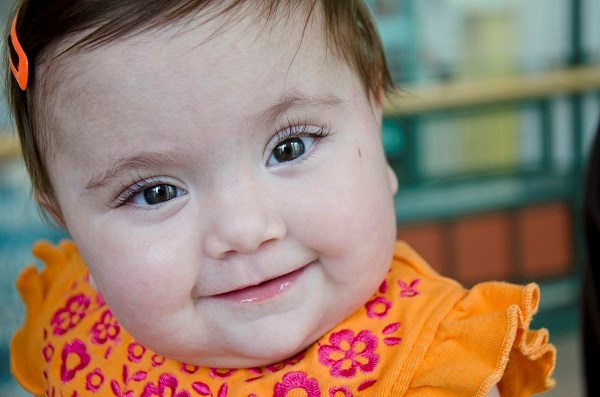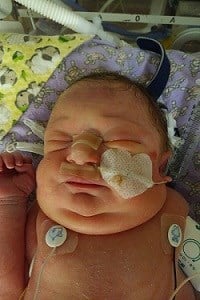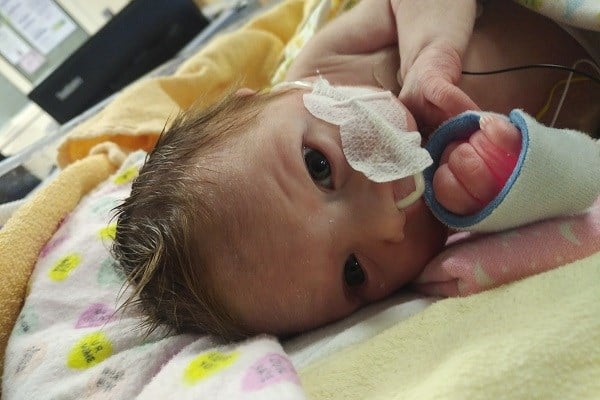Application of a novel dialysis technique at SickKids saves newborn with renal failure
Summary:
A procedure performed at SickKids may give new hope to families with babies in renal failure. Dr. Christoph Licht and his team performed the first clinical application of a modified continuous flow peritoneal dialysis (CFPD) at SickKids on baby Emily.
A procedure performed at The Hospital for Sick Children (SickKids) may give new hope to families with babies in renal failure. Last spring, Dr. Christoph Licht, Staff Nephrologist and Medical Director of the Dialysis and Apheresis Unit and his team performed the first clinical application of a modified continuous flow peritoneal dialysis (CFPD) at SickKids on baby Emily when she was just over a month old and under 2 kg.

Emily, now 11 months, was born with bilateral multicystic-dysplastic kidney disease. Her kidneys do not function at all and produce no urine. Emily is completely dependent on dialysis to clean her blood free from toxins.
“We were told early on in the pregnancy that children with this disease usually don’t survive past birth,” says her mom Rita. “But we had hope and believed in her. When she was three days old, they brought her over from Mount Sinai to SickKids by tunnel.”
At five days old, Emily was put on peritoneal dialysis (PD), the standard version of dialysis for a newborn. In PD, a catheter is inserted into the abdominal cavity, the cavity is filled with fluid, and then is drained. However, due to the distension and pressure involved, it can create problems, such as an impact on blood pressure, prevention of the full expansion of the lungs, or issues with the mechanics of the catheter, such as leaks and infections.

The latter was the case with Emily: her catheter was leaking. “We tried pausing the treatment, sutures and tissue glue and even open surgery to revise the catheter, but it continued to leak from the exit site,” says Licht. “Continuous leaking introduces significant infection risk, as bacteria enter the body. In her weight category, this was life-threatening.
Hemodialysis, a dialysis option where blood is removed from the body through a central line, cleaned and returned to the body, was not possible for Emily. While there is equipment in use around the world to dialyze small babies with hemodialysis, it is not yet available in Canada.
Licht considered CFPD, something that has been discussed in the literature for about the past 30 years, with treatment options being used in South Africa for the past 10 years. CFPD was first introduced at SickKids in the 1980’s by Dr. Denis Geary in a few clinical cases, but there was a lack of equipment and resources available to effectively deliver the therapy. For Emily, Licht and his team decided to try a modified version of CFPD. “We had to make continuous flow work, as there was no viable alternative available to offer life-supporting dialysis,” says Licht.
Different from Dr. Geary’s previous approach which used a double lumen catheter, the team now inserted a second (single lumen) catheter, so there was now one for inflow and one for outflow. The inflow was pumped using a standard IV pump. The outflow was controlled by gravity, altering the height of the outflow tubing to achieve the desired fluid removal (in standard CFPD, the outflow is removed with a pump).
The moment this was working, the leaking stopped. This was enough to stabilize her in the NICU, transition her back to the ward, and eventually, move back to regular PD. She has recently gone through a round of hemodialysis, now that she weighs more, to bridge time until the abdomen has healed from the removal of the second tube and insertion of a feeding tube.
Using CFPD presented some new technical challenges for the team, especially the Pharmacy Department, who had to figure out how to put the commercially available PD fluid into IV bags, as connectors did not exist to hook the PD fluid to a standard IV setup (to infuse into the peritoneum). This was all done as a strict sterile procedure.
“The Pharmacy team already has a full agenda and then we came to them asking for something just outside the box,” says Licht. “But it was to save a child. Immediately, the attitude ‘Let’s meet and see how to make it happen’ was there. No one was prepared to leave the room without a solution.”
“Thank God they came up with this,” says Rita. “It saved her life.”

Licht cautions that CFPD should not become a standard of care, but rather should be considered on a case-by-case basis. “CFPD isn’t to replace conventional PD but to use in scenarios where conventional PD is failing, or you want to make PD more efficient and don’t have access to hemodialysis,” he says.
A group in Virginia that works with SickKids, and a group in Cape Town, South Africa, will be joining forces to report on their experiences with CFPD among the three sites and establish guidelines over how to use it, says Licht.
Next steps for Emily
Now that Emily is out of immediate danger, she will continue to grow until she can receive a transplant. Typically a transplant happens at approximately 10 kg; it can take a baby in renal failure twice as long as a healthy baby to get to this weight, so she will likely reach this weight at the age of two.
Emily has a gastric tube, or G-tube, through which she receives formula specific for her needs; receiving the proper nutritional content will support central nervous system growth and neurological development.
“She will need medical interference, or a transplant, her whole life,” says her dad Kevin. “Unfortunately, neither of us are a match.”
Her parents see her having a transplant before she starts school, although she will likely still be fed via G-tube. Rita and Kevin know she will likely need another transplant as a young adult.
While Emily has a while to wait until she receives a transplant, fortunately, kidney failure can be managed with dialysis for many years so there isn’t the same pressure as in the case of those who need a new heart, lungs or liver, says Licht.
The family self-describes as “lucky” to live in Toronto, about 20km from SickKids. This has also influenced their ability to spend more time at home than someone who is based outside the city. With the help of a nephrologist on call who will return pages right away, more time at home has become an option for them, with Emily undergoing dialysis while she sleeps at night.
Rita and Kevin are grateful for the SickKids team, who “have always taken our concerns seriously, and validated everything we say,” says Rita. They are grateful to the nursing team that has trained them to have the ability to care for their daughter at home.
They also receive support from other patients. “Emily likes it at SickKids,” says Kevin. “She has met more people than other babies her age. She has her family and then she has her SickKids family. Some little girls come in and say hi when they are done their dialysis. She knows she’s not by herself.”
This World Kidney Day, they have a message to share: “20 years ago, she wouldn’t have survived this. We’re glad the research is being done. In her lifetime, we may see kidneys being generated. Keep doing the research!”
Recognizing World Kidney Day
Today is World Kidney Day, a global campaign designed to raise awareness about the importance of our kidneys, the role kidneys play in our overall health and the impacts of kidney disease.
Keep an eye to the sky at sundown tonight, as landmarks all over the world (including many of the GTA’s most famous landmarks, and sites in the United Kingdom and Qatar!) light it up orange in support of World Kidney Day at SickKids. Local landmarks will include the CN Tower and the Toronto sign at Nathan Phillips Square.
Share your selfie at your local lit-up-orange landmark to show your support for kids living with kidney disease and share it with us by using #SKWorldKidneyDay. To join the wider international conversation, include #WorldKidneyDay in your post as well.

